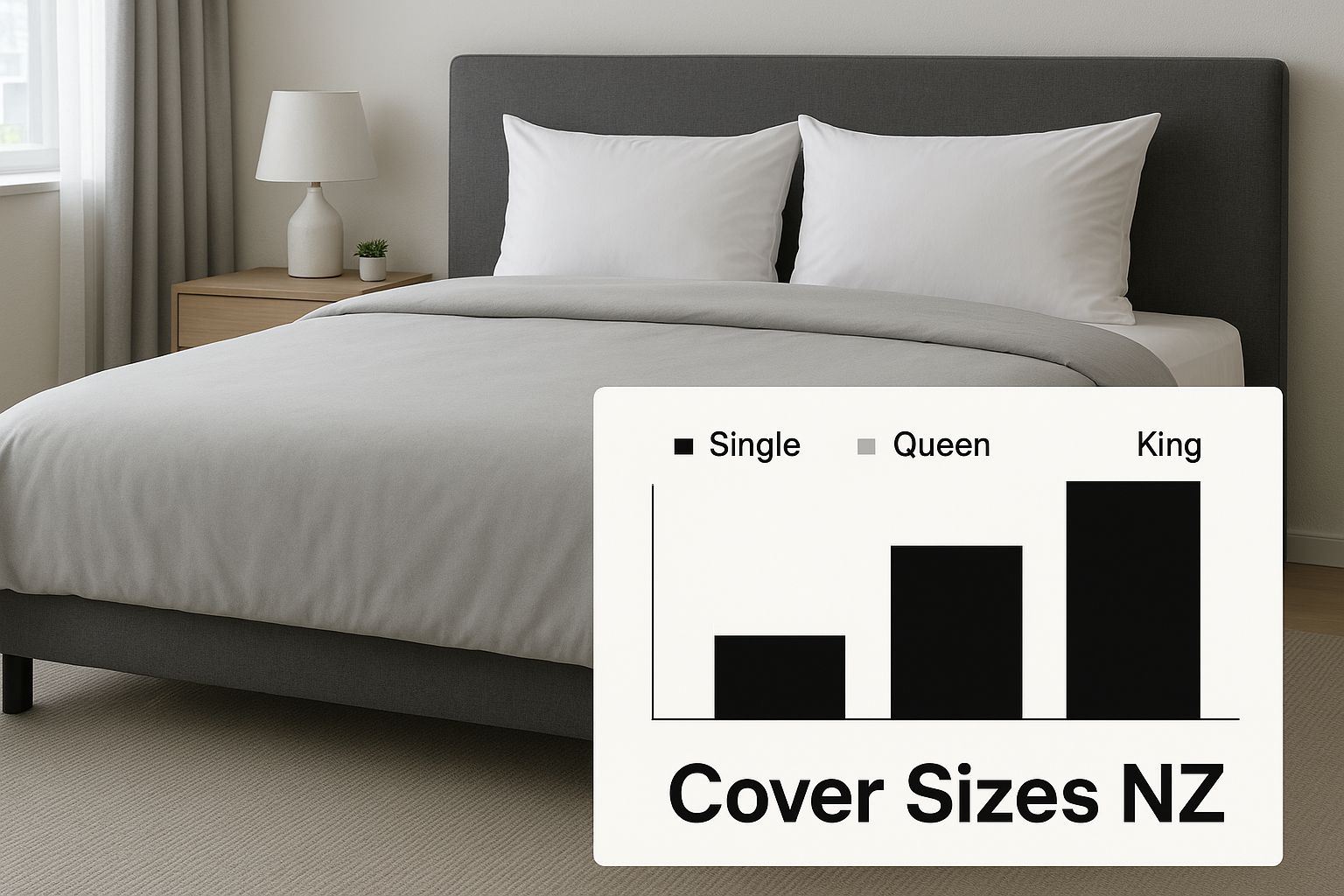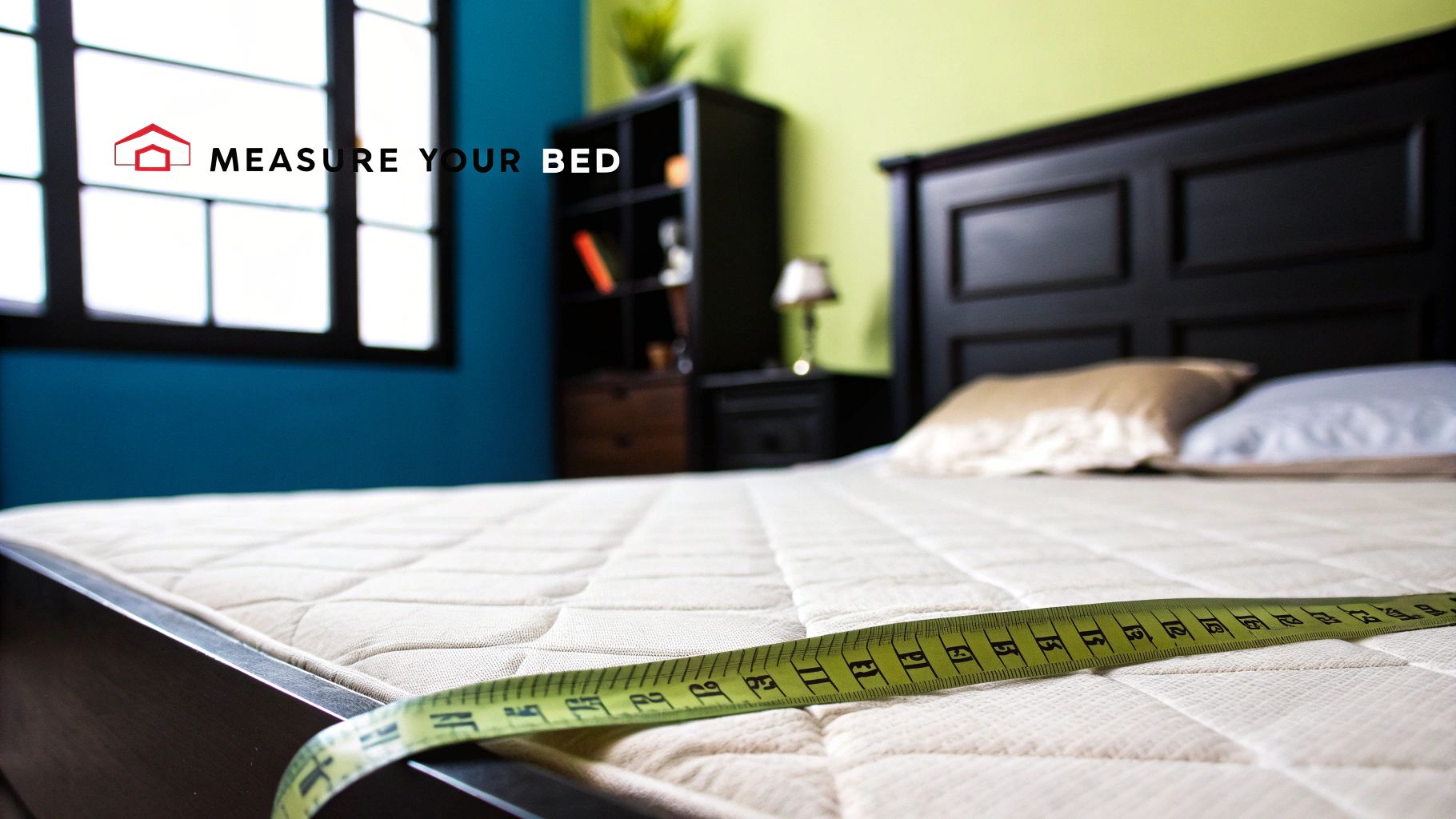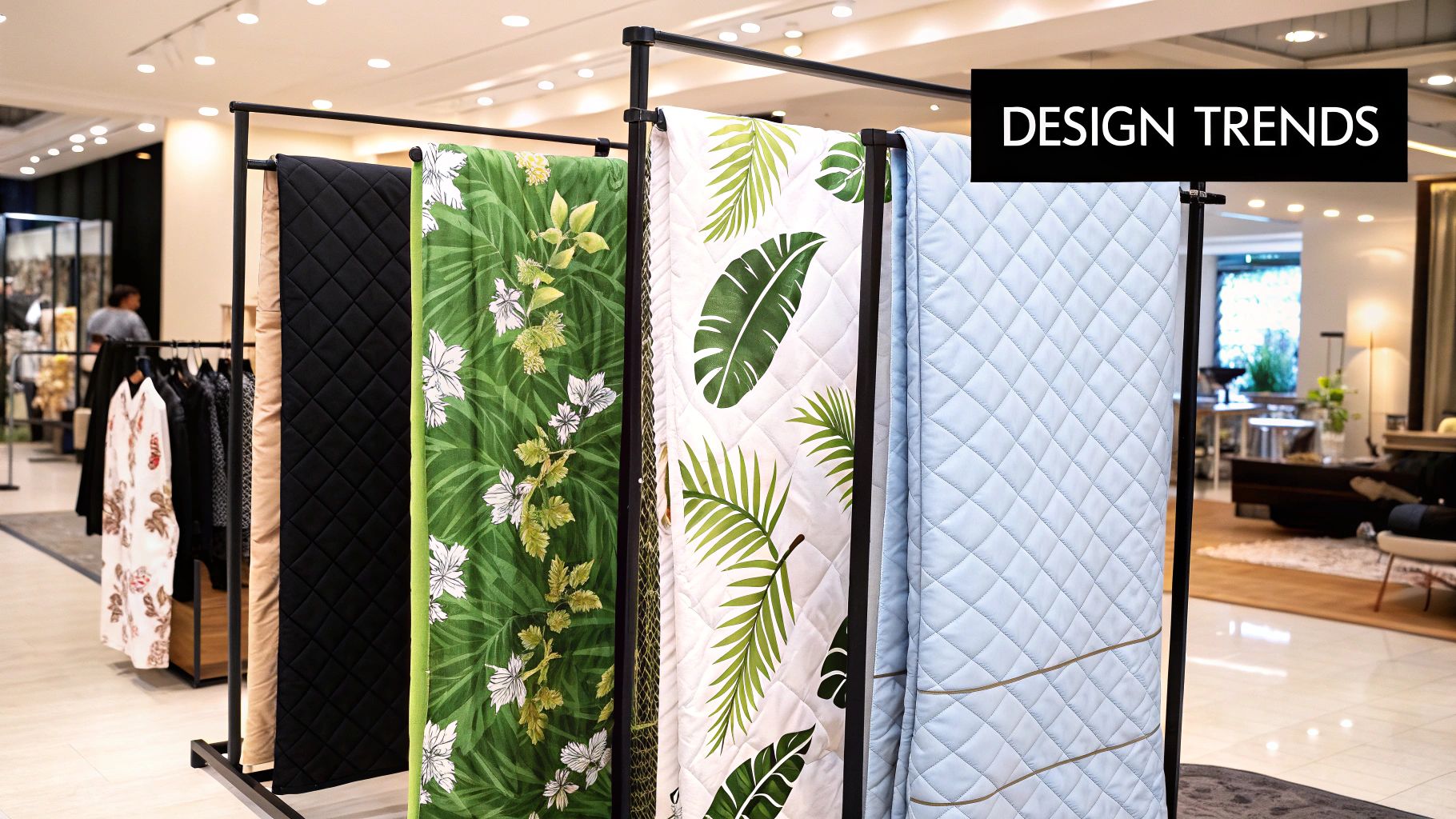Shopping for new bedding should be fun, not a frustrating puzzle.But when it comes to duvet cover sizes in NZ, it's easy to get tangled up in the numbers. The good news is that our local sizes, from Single right up to California King, are standardised to give you that perfect, drapey look over a standard New Zealand mattress. This guide will walk you through the exact dimensions, so you can stop guessing and start shopping with confidence.
The Ultimate NZ Duvet Cover Size Chart
Let's be honest, trying to decipher bedding labels in a busy store can be a real headache. To cut through the noise, I've put together a straightforward chart that matches every standard New Zealand duvet cover with its mattress counterpart. Think of it as your go-to cheat sheet for bedding.
Whether you're giving your own bedroom a fresh look or setting up a cosy space for the kids, getting the measurements right is the secret to a beautifully made bed.

As you can see, the right size isn't just about function; it’s a huge part of what makes a bed look inviting and feel incredibly comfortable.
Standard Dimensions at a Glance
Here in New Zealand, our duvet cover sizes are designed to perfectly complement the mattress sizes you'll find in most homes. For instance, a classic Queen duvet cover measures 210 cm by 210 cm, giving you a neat, square fit. Step up to a King, and you're looking at 245 cm by 210 cm.
If you really love to feel cocooned in your bedding, a Super King offers a generous 265 cm by 220 cm. For the ultimate in luxury and space, the California King is the largest standard option at a massive 270 cm by 240 cm. These specific measurements ensure your duvet inner sits just right inside its cover, without bunching or sliding around. If you're curious, you can find more details on these standard linen sizes and how they match up.
To make it even clearer, here’s a simple table comparing the standard mattress and duvet cover dimensions you'll come across while shopping.
Standard NZ Duvet Cover & Mattress Sizes (cm)
This table provides a direct comparison of standard New Zealand duvet cover dimensions against their corresponding mattress sizes to help you find the perfect fit.
| Bed Size | Mattress Dimensions (cm) | Duvet Cover Dimensions (cm) |
|---|---|---|
| Single | 91 x 190 cm | 140 x 210 cm |
| King Single | 107 x 203 cm | 180 x 210 cm |
| Double | 137 x 190 cm | 180 x 210 cm |
| Queen | 153 x 203 cm | 210 x 210 cm |
| King | 167 x 203 cm | 245 x 210 cm |
| Super King | 183 x 203 cm | 265 x 220 cm |
| California King | 203 x 203 cm | 270 x 240 cm |
This side-by-side view really highlights the intentional "overhang" designed into duvet covers, which is crucial for achieving that plush, comfortable look.
Key Takeaway: If there's one thing to remember, it's this: your duvet cover should always be a bit larger than your mattress. This extra fabric is what allows for a beautiful drape over the sides of the bed and makes room for the thickness, or "loft," of your duvet inner.
Why Finding the Right Fit Can Be Deceiving

Have you ever bought a ‘Queen’ duvet cover for your Queen bed, only to get it home and find it fits terribly? It’s a classic, frustrating moment. Maybe it’s too tight, forcing your duvet inner to bunch up inside, or it’s so loose the whole thing looks flat and sloppy. If this sounds familiar, you're definitely not alone.
It seems so straightforward—just match the size on the label. A Queen cover for a Queen bed, a King for a King. But as many of us have discovered, it's rarely that simple. The world of duvet cover sizes in NZ has a few curveballs that can trip you up. The real issue often starts with the duvet inner itself.
Think of it like putting a big, puffy winter jacket into a sleek coat bag. They might both be labelled ‘Large’, but the sheer volume of the jacket means it’s going to be a real squeeze. Your bedding works on the exact same principle.
The Role of Duvet Loft and Fill
Beyond the basic width and length measurements, the biggest factor at play is the loft of your duvet inner. ‘Loft’ is just a simple way of describing its fluffiness or thickness. This comes down to the type of filling—like down, wool, or microfibre—and its fill power.
A high-loft, ultra-warm winter duvet is much thicker and takes up way more space than a lightweight summer one. All that extra volume essentially steals space inside the cover, making for a snug, compressed fit. You might find the edges of the cover no longer hang neatly over the sides of your bed.
On the other hand, putting a thin, low-loft duvet into a standard-sized cover can leave it looking lost and deflated. The fabric won't be filled out properly, and you lose that plush, inviting look you were going for.
A deep dive into bedding materials shows that natural fillings like goose down can provide about three times more warmth and volume than many synthetic options of the same weight. This high fill power creates an incredibly lofty duvet that needs a lot more room inside its cover.
Don't Forget Your Mattress Depth
Here’s another detail that’s easy to overlook: the depth of your mattress. These days, mattresses are getting taller, especially with all the plush pillow tops and memory foam layers available. A standard duvet might not have enough fabric to hang down and properly cover the sides of a 30 cm or even 40 cm deep mattress.
When the cover is too short, it leaves the sides of your mattress awkwardly exposed, ruining that clean, hotel-style finish. It’s a small thing, but it makes a massive difference to how your whole bed looks. Getting a handle on these subtle details is the first step to finally buying bedding that doesn't just fit, but looks and feels perfect.
A Look at Common NZ Bedding Sizes
Forget just looking at a size chart. To get your bedding right, you need to understand the thinking behind each standard New Zealand size. Knowing the "why" behind the dimensions is the secret to creating a bedroom that not only looks great but actually works for you. From a kid's first bed to a sprawling master suite, each size has a specific job to do.
It’s the difference between a bed that’s just ‘okay’ and one that feels like it was made for the person sleeping in it. Let’s break down what each size is really for.
The Compact Options: Single and King Single
The classic Single bed is a Kiwi staple for good reason. It’s our most compact option, making it the default choice for children's bedrooms, small guest rooms, or any space where you're trying to save on floor area. Its narrow shape leaves plenty of room for desks, toys, or just a bit of breathing space.
But for growing kids, the King Single is a smart move. It gives you the same length as a Queen bed (203 cm) while staying relatively slim. This makes it a brilliant solution for lanky teenagers who’ve outgrown their old bed and need more room to stretch out.
- Single: Perfect for young kids, bunk beds, and squeezing a bed into a tiny spare room.
- King Single: An excellent choice for taller kids, teens, or a single adult in a narrow bedroom.
The Versatile Mid-Sizers: Double and Queen
The Double bed used to be the go-to for couples, but times have changed. These days, you’re more likely to see it in a spacious guest room or as an indulgent choice for a single person who loves to spread out. It offers a welcome bit of extra width over a King Single without taking over the whole room.
Of course, the undisputed champion of New Zealand bedrooms is the Queen. It just hits that perfect sweet spot. For most couples, it provides enough personal space for a comfortable night's sleep without needing the huge footprint of a King. Because it's so popular, you'll also find the biggest and best range of duvet cover styles available in this size.
Choosing the right size is all about balancing your personal comfort with the actual scale of your room. A Queen feels spacious for two people in an average master bedroom, while a Double can feel like pure luxury for one person in a smaller room.
The Luxurious Large Sizes: King, Super King, and Cali King
When you’re ready for some serious, unadulterated comfort, it’s time to look at the larger sizes. A New Zealand King is significantly wider than a Queen, giving both sleepers a noticeable upgrade in personal space. It’s a fantastic choice for couples who don't want to be woken up by their partner tossing and turning.
The Super King takes that luxury to the next level, offering a truly palatial amount of room. This size is ideal for families who love a weekend morning cuddle with the kids, or for anyone with an extra-deep mattress who needs that generous drape from their duvet cover.
Finally, the California King is the absolute pinnacle of space. It’s a perfect square of comfort that makes a bold, grand statement in a large master bedroom. Don't worry, major bedding suppliers create their duvet cover sizes nz ranges to fit everything from a Single right up to a Super King, so you'll always find what you need. In fact, you can see how top brands approach their sizing guides to understand how they cater to every Kiwi home.
How to Measure for a Flawless Fit

Ready to get a perfect fit every single time? The secret isn’t just grabbing a cover that says ‘Queen’ and hoping for the best. It’s about getting hands-on with a measuring tape to find out the real-life dimensions of your bed and duvet inner.
Think of it like getting a picture framed. You wouldn't just guess the size; you'd measure the print first to make sure the frame fits perfectly. Your bedding deserves the same attention. A few minutes of measuring arms you with the exact numbers you need, turning a guessing game into a confident purchase.
Measuring Your Duvet Inner Correctly
Here’s a common pitfall: buying a duvet cover based on the size your duvet inner was when it was brand new. Natural fibres like cotton and linen can shrink a little over time with washing. What might have started as a standard Queen size could now be a few centimetres smaller. The only way to know for sure is to measure it as it is today.
Here’s the simple, foolproof way to do it:
- Lay It Flat: Take your duvet inner out of its cover and lay it on a large, flat surface. The floor is usually best.
- Smooth It Out: Gently pat it down to remove any big wrinkles or clumps of filling. You want it to lie as flat as possible without stretching it.
- Measure the Width: Use a tape measure to get the distance from the left edge to the right edge.
- Measure the Length: Now, measure from the top edge all the way to the bottom.
Jot these two numbers down. These are your magic numbers for matching against the various duvet cover sizes NZ brands offer. Keeping shrinkage to a minimum comes down to proper care, and you can get some great tips from our guide on how to wash linen sheets, as the advice often applies to other natural fabrics too.
Accounting for Your Mattress Depth
Next up is your mattress. Its thickness, or depth, is a crucial piece of the puzzle that many people forget. A modern, deep pillow-top or memory foam mattress needs a lot more duvet to cover it properly than an older, slimmer one.
Pro Tip: If you love that plush, hotel-style look where the duvet drapes generously over the sides, you need to factor in your mattress height. A good rule of thumb is to add the mattress depth to both the width and length you need for your duvet cover. This ensures you get that elegant overhang instead of a cover that barely reaches the bottom of the mattress.
Grab your tape measure one last time:
- Mattress Width and Length: Measure the top surface of your mattress from side to side (width) and from head to foot (length).
- Mattress Depth: Measure the height of the mattress itself, from the very bottom edge to the top. Don't include the bed base or frame in this measurement.
Now you have it—a complete set of measurements for your duvet inner and your mattress. With these precise numbers in hand, you can confidently compare them to any size chart and pick the perfect cover, no guesswork required.
Here is the rewritten section, crafted to sound completely human-written and natural.
Finding Your Perfect Drape and Overhang
Getting the right fit for your duvet cover isn't just about making sure it covers the inner. It’s about creating a look. The secret to that plush, inviting bed you see in magazines often comes down to one thing: the drape. This is simply how much fabric hangs over the sides of your bed, and it’s what turns a regular bed into a hotel-worthy centrepiece.
Think about it like hanging curtains. Curtains that stop right at the windowsill do the job, but curtains that fall gracefully to the floor add a sense of drama and polish. It’s exactly the same with your bedding. The amount of overhang you choose really defines the style of your bed.
Choosing Your Overhang Style
How much drape is ideal? Honestly, it’s all down to personal preference and the type of bed you have. Some people love a generous, floor-sweeping look for that ultra-luxurious feel, while others prefer a shorter, neater overhang that suits a more minimalist space. There's no one-size-fits-all answer, just what feels right for you.
To get you started, here are a couple of popular approaches:
- The Luxurious Drape: For that truly opulent, cocooning effect, a lot of people deliberately size up. Putting a King size duvet and cover on a Queen bed, for example, gives you a beautiful, substantial overhang. This works especially well with taller bed frames, creating a real sense of grandeur and cosiness.
- The Tidy Drape: If you have a low-profile platform bed or just prefer a cleaner, more tailored look, sticking with your bed's standard size is often best. This keeps the duvet from pooling on the floor and ensures the clean lines of your bed frame remain a feature. It’s perfect for that crisp, contemporary vibe.
Expert Tip: As a general rule of thumb, I always suggest aiming for an overhang of at least 30-40 cm on each side. This is usually enough to cover the depth of your mattress completely and give you that satisfying drape without looking messy.
Pros and Cons of Sizing Up
The trick of putting a larger duvet on a smaller bed—like a King on a Queen—is a fantastic styling hack. But before you jump in, it’s worth thinking about whether it’s the right move for your specific setup.
Pros:
- That Sumptuous Look: More fabric instantly makes the bed look and feel richer and more luxurious.
- No More Cover Wars: If you share a bed, the extra width is a game-changer. It’s the simplest solution to stop the nightly tug-of-war for the duvet.
- Hides a Multitude of Sins: A long drape is perfect for concealing a less-than-lovely bed base or any under-bed storage.
Cons:
- Can Look Messy: If your bed is quite low to the ground, all that extra fabric can end up looking untidy or gathering dust on the floor.
- You Need the Matching Inner: This is crucial. You can't just put a big cover on a small inner; you’ll need to buy the larger duvet inner to match, which is an extra cost.
- It Hides the Details: Got a stunning bed frame with beautiful carving or detailing? A long, heavy drape will cover it right up.
In the end, deciding on the right drape is one of the most important steps in creating a bedroom you truly love. It’s where you get to personalise your space and really master the art of duvet cover sizes in NZ.
Comparing NZ Sizes to International Standards
Shopping for bedding online opens up a world of beautiful designs, but it can also be a minefield of mismatched sizes. Have you ever found the perfect duvet cover online, only to realise it’s from an overseas store and the sizing is completely different? It’s a common frustration.
Understanding how our local NZ standards stack up against international ones is the key to avoiding that disappointment and the hassle of costly returns. Think of it like knowing the difference between currencies before you travel. While the names might sound the same—Queen, King, Double—their actual value, or in this case, their dimensions, can be surprisingly different from one country to the next.
A Look Across the Ditch
Let's start close to home. When it comes to our closest neighbour, Australia, there's good news. For the most part, New Zealand and Australian duvet cover sizes are identical. This trans-Tasman consistency makes shopping from Aussie retailers a pretty safe bet if you're looking for more variety.
However, once you start looking further afield, you'll find slight but significant variations. A New Zealand Queen duvet cover, for instance, is a perfect square at 210 cm x 210 cm, matching the Australian standard. But an American Queen is often longer and narrower, reflecting their different mattress dimensions. It’s these small differences that can turn a dream purchase into a decorating nightmare. You can read more about these global bedding differences on reedfamilylinen.com.
Navigating US and UK Differences
The real confusion often kicks in with American and British products. A 'King' in the UK is much smaller than our NZ King, and what the Americans call a 'King' is different yet again. It's easy to get caught out.
To help you make sense of it all, we've put together a quick comparison table. It's a handy cheat sheet for your next online shopping session.
International Duvet Cover Size Comparison (Approx. cm)
| Region | Single/Twin | Double/Full | Queen | King |
|---|---|---|---|---|
| New Zealand | 140 x 210 | 180 x 210 | 210 x 210 | 245 x 210 |
| Australia | 140 x 210 | 180 x 210 | 210 x 210 | 245 x 210 |
| United Kingdom | 135 x 200 | 200 x 200 | 225 x 220 (King) | 260 x 220 (Super King) |
| United States | 173 x 218 (Twin) | 203 x 203 (Full) | 229 x 224 (Queen) | 259 x 229 (King) |
See the differences? A UK King is what we might consider closer to a Queen, and their Super King is what you'd want for a NZ King bed. It pays to check!
Key Takeaway: Never assume the name means the same size. Always, always check the centimetre or inch measurements before clicking 'buy' on an international site. This one simple step will save you from a world of hassle and ensure your new duvet cover fits like a glove.
Knowing these differences empowers you to shop globally with confidence. Of course, if you prefer to stick closer to home, you can check out our guide on finding the best bed linen in NZ for styles designed specifically for our beds.
Common Duvet Cover Sizing Questions
Even with all the charts and measurements in the world, a few specific questions always seem to pop up when you're trying to choose the right duvet cover. It can feel a bit tricky navigating the world of bedding, so let's clear up some of the most common dilemmas people face.
This is your quick-fire round of answers to those last lingering uncertainties. Once we’ve tackled these, you’ll be ready to shop with total confidence.
Common Sizing Scenarios
Can I use a King duvet cover on a Queen bed?
Absolutely! In fact, this is a really popular interior styling trick. Using a larger King duvet (and you'll need the matching King inner to go with it) on a Queen bed creates a beautiful, generous drape over the sides. It’s perfect if you're chasing that plush, five-star hotel look or if you're a couple who values having a bit of extra coverage.
What is the difference between a NZ King and a Super King?
It all comes down to width. A standard NZ King duvet cover is 245 cm wide, whereas a Super King is noticeably wider at 265 cm. That extra 20 cm makes a huge difference, especially if you have a deep, modern mattress or if you're simply tired of the nightly tug-of-war for the blankets.
The choice often boils down to comfort versus a perfectly neat look. A King fits a King bed cleanly, but a Super King provides that luxurious extra space that can make all the difference for a truly restful night's sleep.
Do Australian and New Zealand duvet cover sizes match?
Yes, for the most part, our standard bedding sizes are identical across the ditch. This is great news because it makes shopping from Australian retailers a reliable option. Their Queen, King, and other standard sizes will almost always match what you find here in New Zealand.
My duvet inner has shrunk, what size should I buy?
This is such a common trap! Always, always measure your duvet inner before you buy a new cover, especially if it's been washed a few times. Natural fibres like cotton can shrink, so relying on the original tag can lead to a poor fit.
Just lay your inner flat on the floor or bed, measure its current width and length, and then choose a cover that’s closest to those new numbers. When you consider the benefits of sleeping in pure linen, it’s well worth understanding how different natural fabrics can change and settle over time.
At The Foxes Den, we believe that the perfect bedding is the foundation of a beautiful sanctuary. Discover our collection of luxurious, high-quality linens designed to bring timeless elegance to your home. Explore our curated homewares.


